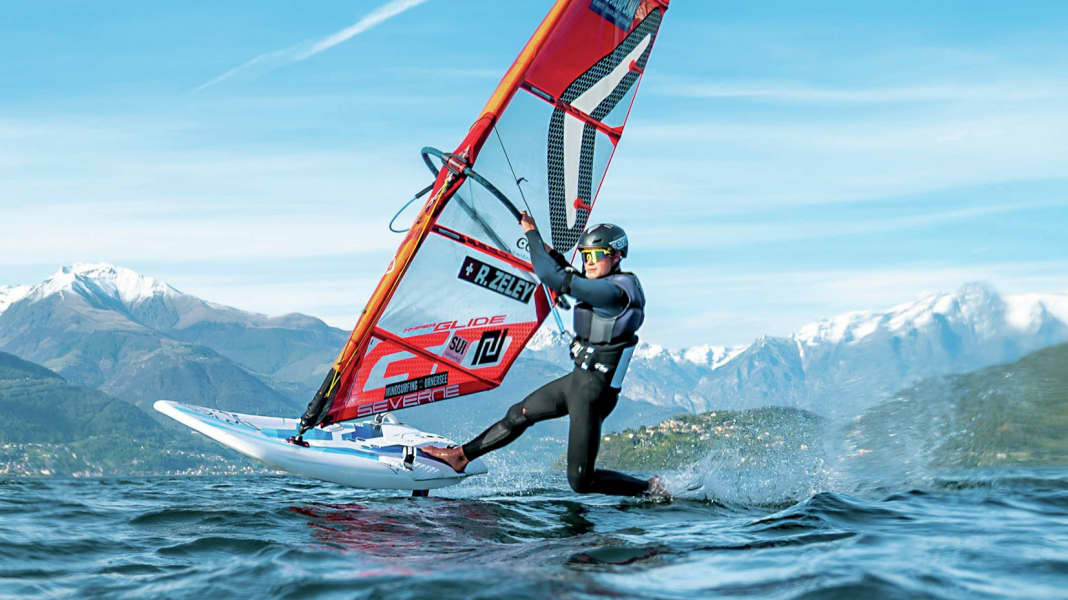
RobinZeley is one of the best young surfers in the Olympic iQFoil class and has his sights firmly set on the 2028 Olympic Games. To make his dream come true, he is already going full throttle. We caught up with him for an interview - between school and training.
Robin, you are part of the Swiss iQFoil team. The Olympic discipline is considered highly competitive and very training-intensive. What does your everyday life look like?
I go to school in the morning and in the afternoon we train on the water or in the gym. In the evening, there's usually a stretching session. I go to the art and sports school: there are footballers, ice hockey players, windsurfers and so on. I'm lucky that I can get to this school in 20 to 30 minutes by train. In summer 2024, I'll start a commercial apprenticeship. There are four boys and two girls in the national team - and when we have a training camp, we're on the water for three to four hours when it's windy. In the evening we have tactics training. If there's no wind, physical training is on the agenda, i.e. running sessions or strength training in the gym.
Your life is tightly scheduled for a 16-year-old. At your age, you normally have other things on your mind: parties, enjoying life. Do the fixed structures sometimes get on your nerves?
I actually think it's good the way it is. My colleague Devin Hauser is also in the iQFoil team and I do a lot together with him. We go to school and train together. But of course, sometimes I'd like to do something different and go surfing or wingsurfing. But then at some point you have to have your big goal in mind again - and keep going.
What is your specific goal?
Definitely the 2028 Olympic Games in Los Angeles. It's still a while away, but I have my sights firmly set on it.

You are currently one of the best young foilers in your age group. What do you still need to work on to make the dream of the Olympics come true?
I need regatta experience, you can never have enough of that. Training is important, but you learn the most from regattas.
L.A. will be different to your training grounds at home. Are you already dealing with this?
No, that's still too far away, a lot can still happen before then. Of course, when it does, you have to train in the right areas to be able to ride well there. I'm still a bit light at the moment and I'm working on getting more strength, mass and, of course, endurance.
How did you get into foiling in the first place?
When I was twelve, I was at Lake Silvaplana and Balz Müller was already freestyling with a foil back then. Balz motivated me to try out a foil and gave me some help. It was great fun right from the start - and at some point Father Christmas put a Naish freeride foil under the tree. The foil was the solution to all my problems on the lake. Suddenly I could simply fly through the wind holes. We often have ten to 15 knots here on the lakes. With a fin it's often stop-and-go, with the foil you just keep flying endlessly.
At my spots, the foil was my salvation. Stop-and-go became endless flying."
You need materials - and travelling is not cheap. You put your annual costs at CHF 35,000. Who supports you?
My family is really supportive, and I'm very grateful for that. Everyone in my family is a water sports enthusiast. My father has been windsurfing for a long time, my mum and my younger brother are active wingfoilers. A considerable part of the costs are paid for by the national team, and Patrik Diethelm also supports me. He is also Swiss, my father has known him for a long time. He mainly helps me with training opportunities with him in Australia. I can train there and he also supports me with equipment for wingfoiling.
You also go wingsurfing a lot. Complement or conflict of interest?
I also race in wingfoiling and think it's a great addition to windsurf foiling. I feel that I can pick up things that help me on the iQFoil, for example the pumping technique or tactics at the start.
Are you active in other disciplines in addition to windsurfing? Or are you fully committed to foiling?
The bottom line is that I'm focussed on foiling. But when the opportunity arises, I also like to jump on the slalom board or the freestyler.
In the PWA World Cup, racers can choose their material freely, depending on the conditions. In the iQFoil, the same 9.0 sail is always used, even at 30 knots. Isn't that sometimes torture?
Of course, that's part of the fascination. You have no choice. No matter what the wind is like, you go out and try your best. And even if the material is supposedly the same, there are of course production-related differences. In practice, you have several masts and try to find the best mast for the race. The same applies to the foil.
Robin, thanks for the interview - and good luck on your way to LA!
Robin Zeley Facts
- Age: 16 years
- Place of residence:Zurich/Switzerland
- Profession: Pupil, K&S sports school, from summer United School of Sports Zurich
- Size/weight: 180 cm/ 64 kilos Has been surfing since: 6 years old Regatta debut: 2016
- Successes: 5x Swiss Champion U15, 1x Swiss Champion U19, 18th World Championship U17 iQFoil
- Favourite spots: Lake Uri, Silvaplana, Margaret River (AUS)
- Favourite moves: 720s on the wingfoil
- Hobbies: Windsurfing, wings, pump hockey, floorball
- Sponsors: My family; Foil Mania Youth, Patrikwindsurf, Windsurfing Urnersee, Maximumsurf, Cerjo, pitsch fitness, Focuswater
- Social Media: @robinzeley

